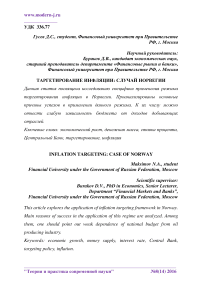Inflation targeting: case of Norway
Автор: Gusev D.S.
Журнал: Теория и практика современной науки @modern-j
Рубрика: Основной раздел
Статья в выпуске: 8 (14), 2016 года.
Бесплатный доступ
This article explores the application of inflation targeting framework in Norway. Main reasons of success in the application of this regime are analyzed. Among them, one should point out weak dependence of national budget from oil producing industry.
Economic growth, money supply, interest rate, central bank, inflation, targeting policy
Короткий адрес: https://sciup.org/140269743
IDR: 140269743
Текст научной статьи Inflation targeting: case of Norway
Norway's experience in inflation targeting is very interesting for Russia, since Norway and Russia are major exporters of raw materials and Norway has successfully applied the experience of inflation targeting to this day.
In 2001, the first year in Norway was the enactment of two laws: about the Bank of Norway and on Public Finance. These laws are much determined the future success of the inflation-targeting regime. The Finance Ministry has convinced the public of the need for government loans, since government budget is in surplus, and the volume of the current account is increasing from year to year. Solving the problem of the excess of the issue aimed at financing of the budget. Stabilization of inflation has also strengthened NOK against the currencies of Norway's partners. [1]
During the years of inflation targeting, there was no significant increase in volumes of production. The Norwegian Central Bank indicates that economic growth is not linked to economic policy. Of course, soft regulation can lead to economic growth in the short term, but in the long run, accelerating inflation negates all the growth and disrupt the macroeconomic balance. Under macroeconomic stability, the Bank of Norway implies a positive effect of monetary policy on sustainable parameters of economic growth, low unemployment and budget surplus (or lower deficit).
Inflation in Norway is affected by such factors as rising real estate prices, and this is accompanied by several factors:
-
• in Norway, real estate prices are included in the underlying index, subject to the regulation regime of flexible inflation targeting;
-
• growth in property prices is forcing citizens of Norway to take on more credit, which in turn leads to an increase in aggregate demand which has a negative impact on inflation.
In view of the important role of the real estate market in Norway, the government has increased its influence on the real estate market, aiming to reduce the volatility in the market.
The Central Bank of Norway for 4 years (2004-2008) was increasing the refinancing rate as in comparable countries applying inflation targeting regime, it was at a relatively low level or even decreased. However, this initiative did not bring the desired results. Regulation of real estate prices with interest rates is almost impossible, because of the difficult detection of deviation determined by general economic factors.
The Norges Bank implements its decisions through a set of monetary policy instruments, which allow it to adjust the amount of liquidity in the banking sector and to influence effectively short-term interest rates. With the help of the transmission mechanisms, the Bank of Norway provides optimal conditions for exposure in money market and short-term interest rates. The Bank of Norway thinks of these mechanisms initially as exceptional and important. To justify the level of adequate short-term interest rates, The Norges Bank has developed a comprehensive mechanism of monetary policy, which accepts all major decisions. Also it has developed a long-term strategy based on a systematic approach to decision-making in the field of monetary policy. Such an approach enhances the credibility of the Bank of Norway, minimizes inflation expectations and also explains the transition from the policy of targeting the money supply, the exchange rate and the classical inflation targeting.
To assess level of inflation, the Norges Bank uses the consumer price index excluding energy prices. It is connected with various methods for drawing up indices set and a different way of weighting the prices included in the index of goods and services.
The Norges Bank, like other Central banks use operations in the open market as the main mechanism of monetary policy. Thus, it appears to have a direct impact on the liquidity of monetary market through interbank market rate - Overnight. In Norway, this rate is called the call money rate (demand rate).
Given the important role of the interbank interest rate as the most important channel of transmission of decisions related to monetary policy, Bank of
Norway officially forms the target value for this rate. In the event of a change in interbank interest rate, the Bank of Norway shall promptly inform the public that there has been a deviation from the target rate.
The Norges Bank carries out daily operations on the open market, uses the American system of auctions, Debt Agency, and Treasury Bills. The main form in which these operations are conducted is REPO, maturity generally ranging from one day to three months. The most common agreements are for a period of days or a week.
Norway's experience shows that in a constantly changing economic reality one should not set too ambitious targets for reducing inflation if there are additional macroeconomic challenges in the financial sector. However, Norway as well as New Zealand, have successfully coped with all the macroeconomic challenges and stabilize inflation at an acceptable level.
Список литературы Inflation targeting: case of Norway
- Басс А.Б., Бураков Д.В., Удалищев Д.П. Тенденция развития банковской системы России: монография. М.: Русайнс. - 2015. - 216 с
- Басс А.Б. Инфляционные процессы в России в условиях кризиса /А.Б. Басс// Экономика. Бизнес. Банки - 2016. - №2(15). - С. 82-92
- Басс А.Б. Таргетирование инфляции в России и цены на продукцию естественных монополий /А.Б. Басс/ Банковские услуги. - 2015. - №5. - с. 10-13
- Бураков Д.В. Управление цикличностью движения кредита: монография. М.:Русайнс. - 2015. - 288 с.
- Финансы, деньги и кредит: учебник и практикум для академического бакалавриата под ред. Буракова Д.В. - М:Юрайт. - 2016. - 329 с.


